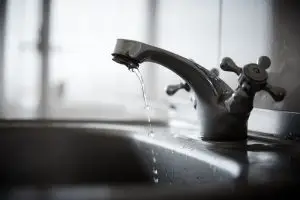Drip, drip, drip – you know the sound. It’s a constant drip or drizzle from your bathroom sink, bathtub, laundry sink, or kitchen faucet. While water trickling or dripping from your faucet is a pretty obvious symptom of a faucet leak, many leaks are much sneakier and you won’t be able to spot them quite as easily.
The experts at Plumbing by Jake share some common signs of a leaky faucet and how you might be able to address them. However, if you know you have a faucet leak situation and need someone to stop the water waste (and the endless dripping sound) right away, give us a call at (702) 948-7201. We even provide 24-hour emergency service if your leak has turned into a flood.
Small Leaks Cause Big Problems
Leaking faucets dripping at the rate of once per second can waste more than 3,000 gallons of water per year, according to the Environmental Protection Agency’s (EPA) WaterSense program. Not only is that a lot of wasted water, but it’s also water you’re paying for. For each leaky faucet in your home, your water bills can increase by as much as 10%.
A leaky faucet fixed quickly is unlikely to cause additional damage. But a faucet that drips freely over a longer period of time can cause:
- Permanent mineral stains in your sink
- Clogged and overflowing drains
- Water leaking under your sink causing water stains on cabinetry or even water damage leaking through to floors or ceilings
- Deteriorating grout and caulk
- Landscaping or foundation issues caused by accumulating water due to an outdoor faucet leak
How to Spot a Faucet Leak
Aside from seeing and hearing the leaking faucet, if you suspect you may have a leaky faucet, check your water bill. The average person uses between 80 and 100 gallons of water per day, according to the U.S. Geological Survey. If you find your water bills suddenly skyrocketing and you have not added additional people to your household, a leak could be the cause.
Check the Angle
If water is not flowing from your faucet in a generally straight line but from crooked angles and sputtering loudly, there could be anything from minor part damage to major interior faucet deterioration.
A Noisy Handle
Turning your faucets on and off should be a smooth, silent operation. If it becomes difficult to turn the handle(s) or they make a squeaking or scraping noise, you have a problem. Sometimes, it’s an easy fix when you unscrew the handle cover and squirt with a little household lubricating spray.
However, the issue may be more serious than some lubricant can correct. The faucet handles can become stuck, sometimes when the water is turned on.
Deposits on the Faucet
A build-up of minerals or rust typically means it’s time for a new faucet. Hard water stains can be removed with specialized cleaning products and a little elbow grease, but minerals and rust are indicators that the materials in your faucet have deteriorated seriously.
Sounds Other than Dripping
Screeching or shrieking faucets can be creepy, but that noise is usually just telling you a rubber washer has hardened and needs to be replaced. However, clicking or clanging sounds may be coming from the faucet or the pipes and will likely need to be checked over by a professional plumber to properly diagnose the issue.
Water Spots Away from the Sink
Dried water rings on cabinetry under the sink, water spots on the floor, on drywall, and on ceilings can signal a leak.
Don’t write off water spots as an unsolved mystery. If you see a water spot in your home, check its proximity to a faucet and you may discover a leak you didn’t even know you had. Similarly, warped wood under a sink cabinet also indicates a leak.
Loose Faucets
Faucet handles or heads that jiggle and loosened showerheads are prime candidates for leaks. A loose connection between these components and your pipes can let water slip out.
Check for Puddles
Leaks don’t just happen from faucet heads, water can pool up around the base of the faucet when the faucet is turned on. A cracked or worn O-ring could be to blame or, less commonly, a valve cartridge could be the culprit.
Remember, Outdoor Faucets Leak Too
Because we don’t spend a constant amount of time near outdoor faucets, by the time you suspect a leak, it’s probably been happening for a long time. Sometimes the cause is minor, such as a loose packing nut or worn-out washer. Often, outdoor spigots are damaged by ice, frost, or cold weather.
Outdoor faucet leaks may also be causing indoor drips, so they should be addressed as soon as they are discovered. The problem could be the faucet itself, but it could also be an issue with the pipes leading to the outdoor spigot.
Contact Us Today to Get Your Leaky Faucet Fixed
Whether you’re uncomfortable attempting to fix your leaky faucet on your own or your do-it-yourself fixes haven’t worked, call Plumbing by Jake at (702) 948-7201 and we can stop the leak. We offer a reliable response time, plumbing expertise, fair, up-front pricing with no surprises or hidden fees, and a 100% satisfaction guarantee.

